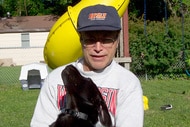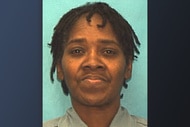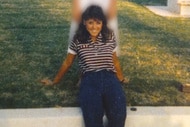Create a free profile to get unlimited access to exclusive videos, breaking news, sweepstakes, and more!
Everything to Know About Carol and Charles Stuart and the Misguided Search for the Pregnant Woman's Killer
Carol DiMaiti Stuart was killed in 1989 during what her husband claimed was a robbery by a Black man wielding a gun. Months later, it came out that he did it.

A young and affluent Boston couple were just about to welcome their first child in 1989 when the pregnant woman was shot, killing the mom-to-be and eventually, her baby.
The murder of Carol DiMaiti Stuart sparked a months-long investigation in which Black men across the city fell under suspicion after a lie told by her husband.
Carol’s husband, Charles Stuart, told police that he and his wife were robbed in Boston’s Mission Hill neighborhood as they were leaving a birthing class, according to The Boston Globe. He identified an unknown Black gunman as the suspect police should be looking for.
The story of the idyllic Boston family, who had been heralded as a “Camelot couple,” quickly unraveled when Charles’s brother told police that Charles was involved in his wife’s shooting, The Globe reported. The widower then took his own life a few months after the shooting.
His actions left a community confused and recovering from the chaos of a false narrative.
Who are Charles and Carol Stuart?
By 1989, the year Carol was killed, the Stuarts had been married for four years. They lived comfortably in Reading, a suburb outside of Boston, according to The New York Times. Charles was a furrier on Newbury St. making $100,000 and his wife, a successful lawyer.
Charles’ friend David F. MacLean told Boston’s WCVB-TV in 1990 that, at a dinner together before Carol’s murder, Charles revealed he was upset that Carol refused to get an abortion, according to the Chicago Tribune. He was worried that she would quit her job to take care of their child, subjecting the couple to possible financial strain.
MacLean also told the Boston television station that Charles then asked him to help kill his wife.
What happened to Carol Stuart?
On October 23, 1989, Charles cried to a Massachusetts State Police dispatcher: “My wife’s been shot. I’ve been shot,’’ according to Boston.com, citing a transcript of the 911 call.
The call recorded the dispatcher’s efforts to pull details of the Stuarts’ location through Charles’ rambling. Charles told the dispatcher he was on Tremont St., adding: “Oh, man, I’m gonna pass out. ... It hurts, and my wife has stopped gurgling, she’s stopped breathing.”
Police got to Charles’ blood-soaked vehicle and discovered he had been shot in the stomach. Carol, his pregnant wife, had been shot in the head.
Carol was rushed into surgery at Brigham & Women’s Hospital, the same facility where just hours before, she had attended a birthing class with her husband, according to Boston.com.
In the early hours of October 24, Carol succumbed to her injuries. Her baby was delivered via Cesarean section, but didn’t make it passed day 17 of his life.
Her husband’s claim that an unidentified Black man attacked them was the start of a furious manhunt to find the suspect.
“It was like a police riot,” Roxbury resident Frederick Johnson told The Washington Post. Then-Boston Mayor Raymond Flynn ordered more than 100 extra police officers to scour through the city’s Black neighborhoods.
RELATED: What Happened to Sierra Joughin, Who Disappeared During a Bike Ride in 2016?
“There were swarms of police on the streets,” Johnson said, recalling how many men were stopped and frisked daily because of their vague similarity to the description of the suspect given by Charles.
Who is Alan Swanson?
As the manhunt for Carol's killer took root in the Mission Hill neighborhood of Boston, police arrested Alan Swanson, a Black homeless man squatting in the housing projects, who owned a sweatsuit like the one the alleged assailant was described as wearing during the attack, according to The Washington Post. From October 24 through 28 of 1989, there had been upwards of 150 “stop and frisk” incidents in the neighborhood each day, according to The Washington Post. Swanson was released in November when police brought in a new suspect, Willie Bennett, who had previously served prison time for shooting a police officer.
Who is Willie Bennett?
Aside from his criminal history, Bennett matched Charles' description of his wife's alleged killer, being roughly the same age and height, along with having a raspy voice.
When Bennett was presented in a police line-up, Charles had a “strong physical reaction,” Boston.com reported.
"I know I didn't do it. They know I didn't do it. It's just that I had a reputation in the projects and everything that happened in Mission, they were considering it was me," Bennett told WBZ-TV in 2017.
Suspicion of Bennett was dropped when on January 3, 1990, Charles’ brother Matthew went to authorities to come clean about what really happened to Carol.
Matthew’s attorney told The New York Times in 1990 that on the night of October 23, 1989, he believed he was helping Charles pull off an insurance scam involving some jewelry. In exchange for $10,000 for his role, Matthew said he met Charles near the hospital — where Charles and his wife left their Lamaze class — and received a bag from Charles that he later discovered contained a handbag, jewelry and a .38-caliber revolver, which Matthew said he dumped over a crossing known as the Dizzy Bridge.
RELATED: Who is Dru Sjodin, Whose Murder Changed the Way We Track Sex Offenders?
Bennett told WBZ-TV that if it wasn’t for Matthew’s confession, he had “no doubt” he would’ve ended up in jail for Carol's murder.
"I ain't got nothing to say about that man,” Bennett said of Charles, calling him a “monster.” “He did what he did and now he's gone. I'll see him in hell, if there is a hell."
What happened to Charles Stuart?
The same night his brother told police the truth about what happened to his wife, Charles drove his car to the Tobin Bridge, where he jumped from approximately 145 feet to his death, according to Boston.com.
He left behind a note in which he did not admit guilt in the murder of his wife. Charles' death came as police were just hours away from arresting him.
In 1991, Matthew was convicted of obstruction of justice and insurance fraud for his role in the crime, Boston.com reported. He died of a drug overdoes 20 years later in a city homeless shelter.
As the news broke of Charles’ suicide and guilt, the residents of Boston went from feeling sorry for who they thought was a helpless widower to feeling outrage for his crimes.
“Mission Hill has come a long way from the hell we were put through 20 years ago,” Ron Bell, who served as director of the Tobin Community Center after the murder, told The Boston Herald in 2009.
Since Carol’s murder, her family started the Carol DiMaiti Stuart Foundation Inc., which was set up to grant college scholarships to students from the Mission Hill area to “promote better race relations throughout the city and greater Boston,” the Los Angeles Times reported in February of 1990.
“All she ever wanted was to be a good daughter, wife and mother and be happy in her life,” Giusto DiMaiti, Carol’s father, said during a press conference three weeks after Charles' death, according to the Los Angeles Times.
“I think there’s an unspoken bond between us and the residents of Mission Hill,” Carol’s brother Carl DiMaiti said. “An unspoken bond as victims.”





























